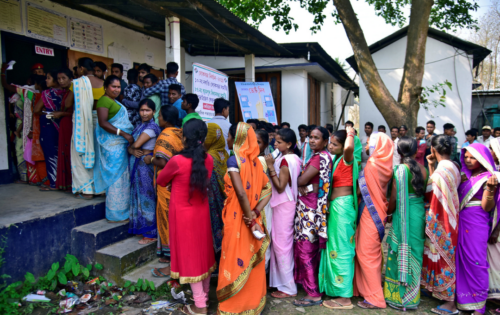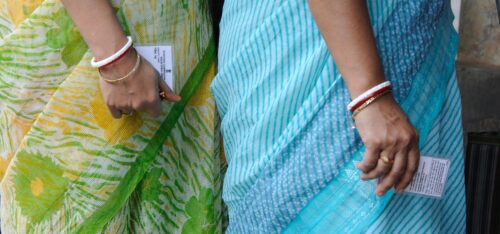
Video
Commentary
Börje Ljunggren looks back at many of the profound transformations shaping India today and ponders the future of the world’s largest democracy under Modi.
In just a few days time, on April 19, India begins its parliamentary elections. With nearly a billion eligible voters, India’s elections are often described as the world’s largest democratic exercise — yet they are deeply unsettling. Modi’s win could signal the end of a pluralistic India that has been embraced by the West as an ally against an authoritarian China. The election process is more protracted than ever, lasting for six weeks, which greatly benefits Modi’s party with its exceedingly well-stocked campaign coffers filled by oligarchs and by alleged abuses of tax and investigative agencies. The results, destined to confirm Modi’s rule, will be known on June 4.
I visited India for the first time over 50 years ago. It was an India by Gunnar Myrdal in his Asian Drama (1968), prior to the Green Revolution, described as doomed to ever deeper poverty. I have since often returned there in my different roles in Swedish development cooperation and diplomacy. However, when I recently spent a month in India, it had been 10 years since my last visit. Now I was confronted with Modi’s India.
Our media are dominated by images of India’s economic growth, and India is surely changing. Striking is how the middle class has grown and how India has become digitalized. Over 900 million people have internet access, and the country is the world’s second-largest online market, with short-cutting online banking and Modi-labeled benefits. The country’s infrastructure has undergone huge improvements. Twenty cities now have a modern subway system.
At the same time, poverty has deepened for vulnerable groups and disparities have grown wider. Growing regional differences are another striking feature of modern India. Life expectancy is a significant indicator. India’s average life expectancy stands at 70.4 years, several years lower than in neighboring Bangladesh (73.8 years). It is particularly low in Modi’s stronghold in northern India, where, for example, Uttar Pradesh with its more than 200 million inhabitants has a life expectancy of only 66 years, compared to over 72 years in Tamil Nadu in southern India — the bastion of anti-Modi resistance, governed by a regional party. None of India’s successful southern states are governed by the BJP. These significant regional socio-economic disparities have led Modi to postpone the country’s already delayed census until after the election. Environmental progress may be the most serious aspect of what has not occurred during Modi’s tenure. In Yale University’s Environmental Performance Index, India ranked 178th out of 180 countries in terms of air quality in 2023.
Another image is that of India as an emerging power, and India is indeed on its way to becoming not only the dominant power in South Asia but also an increasingly assertive global power. “A nationalist outlook will naturally produce a nationalist diplomacy, and it is something that the world will need to get used to,” Indian Foreign Minister Subramanyam Jaishankar argued in a recently released book. Foreign policy has also become increasingly identity-driven. Modi, who after the 2002 massacre of Muslims in Gujarat, where he as chief minister remained passive, was long denied a visa to the USA. Today, he is welcomed as an indispensable friend, when both the US and India see China as a dominating threat. At the same time, India retains its traditionally close ties to Russia, as illustrated by India’s stand on Ukraine.
India is changing. This picture of a changing India must not obscure the most profound transformation that India is undergoing, the identity change that Modi is determined to bring about.![]()
Börje Ljunggren
India is changing. This picture of a changing India must not obscure the most profound transformation that India is undergoing, the identity change that Modi is determined to bring about. After his ten years in power, we are already facing a dramatically different India. The prominent Indian historian Ramachandra Guha, author of India after Gandhi (2007), notes in the latest issue of Foreign Affairs, that Modi’s influence goes deeper than what he has achieved materially. His supporters “proudly boast that India has rediscovered and reaffirmed its Hindu nationalist roots, leading to a decolonization of the imagination — a truer independence than Mahatma Gandhi’s freedom movement ever achieved.” Modi’s government “actively works to intensify both religious and regional conflicts, in ways that will strain the country’s social fabric.”
India has nearly 200 million Muslims who today see their citizenship being diminished. The construction of a Hindu temple in Ayodhya — at the site where a mosque in 1992 was demolished by a Hindu mob, is hard to misinterpret. The temple was inaugurated in early 2024 by Modi, who declared that the temple “symbolized a new era for India” — a more authentic India. Religion and politics are becoming increasingly amalgamated.
This is how the landscape looks ahead of the elections, which are very likely to give Modi and his BJP alliance a continued clear majority, not in terms of votes but, with India’s first past the post system, in terms of seats in the Lok Sabha, the national parliament. The Hinduization of India, Hindutva, will deepen. Modi is in the process of deconstructing the secular India that won its independence in 1947, under the leadership of Mahatma Gandhi and Jawaharlal Nehru. Today, the focus is on identity, not issues. India’s entire political culture is shifting toward what today by scholars are called “ethnic democracy,” “majority democracy,” “toxic majoritarianism,” and “competitive authoritarianism.” All pointing in the same worrisome direction. The formal architecture of democracy is maintained, but its institutions are systematically weakened.
Illustrative is how India’s ranking in our most recognized democracy indices has changed. Increasingly respected, Gothenburg-based V-Dem (Varieties of Democracy) designates India in its latest ranking as an “electoral autocracy” and places India as the 104th out of 180 countries. Reporters Without Borders, in its latest ranking (2023), ranks India, known for its independent quality press, at 161st. However, India is far from being a monolithic authoritarian state, and critical media outlets, such as Hindustan Times and the brave online newspaper The Wire, still exist, albeit threatened. Foreign correspondents on the ground, as well as freelance journalists who travel temporarily, increasingly refrain from investigating and reporting on topics they would like to cover. In early 2023, police raided the BBC offices in New Delhi and Mumbai after the BBC aired a two-part documentary called “India: The Modi Question,” about Modi’s actions during the deadly riots in Gujarat in 2002. Most mainstream media outlets are now owned by wealthy businessmen close to Modi.
Who then is Modi, the man who today almost totally dominates India’s political life and reshapes its history? Unlike the previously predominant Congress Party, currently led by Rahul Gandhi, the fourth generation of the dynastic Nehru-Gandhi (Indira) family, Modi is a self-made man from a low caste background. Already as a teenager, he joined RSS — Rashtriya Swayamsevak Sangh, a Hindu-nationalist paramilitary organization, to which he has remained loyal. With great skill, he has cultivated a personality cult and rallied significant portions of financial capital, the oligarchs, behind him. People vote for him rather than for the BJP. Power has been centralized, and the country’s federal structures weakened, undermining the federal compact.
Characteristic of Modi is his disdain for the opposition and its legitimacy. The opposition, of course, also bears significant responsibility for this development. What has become of the Congress Party, which for decades was the ruling party? Today, it holds barely 10 percent of the seats in the Lok Sabha, and its figurehead, Rahul Gandhi, who reluctantly entered politics following the assassinations of his father Rajiv Gandhi and his grandmother Indira Gandhi, struggles to convince. Hope is pinned to the opposition’s efforts to unite ahead of the election, an endeavor that at best can best described as a growing, but insufficient. The tension between Modi’s highly successful brand of Hindu populism and democracy will grow, and further divide the country.
Nobel laureate in economics, Harvard professor Amartya Sen, is one of Modi’s most vocal critics. Sen has dedicated his entire life to advocating for a different India, based on diversity and inclusivity. Modi’s “cementing of Hindu rule” and “an atmosphere of intolerance” run counter to everything Sen has fought for in his efforts to expand people’s “real freedom.” Sen generally refrains from signing petitions, but in late March, he made an exception when he, in a separate statement, marked by his profound disappointment with societal developments, joined criticism of the increasingly widespread occurrence of politically driven detentions without trial. “We should,” he stated, “very much hope that the judicial system of India will have the good sense to eliminate barbarities of this kind.”
Behind Modi’s facade of triumph and power lies, Ramachandra Guha notes, “a more fundamental truth: that the most important source of India’s survival as a democratic country, and its recent economic successes, has been the country’s political, economic, and cultural pluralism, precisely the qualities that the Prime Minister and his party are now attempting to erase.”
Börje Ljunggren is a former head of the Asia Division at the Swedish Ministry for Foreign Affairs and Ambassador to China. He is a Senior Associate at the Swedish Institute of International Affairs and an Associate at Harvard’s Asia Center.
Video
